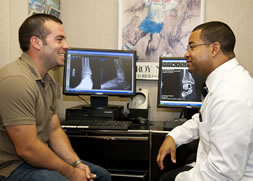Foot and Ankle Specialists of CT
Best Orthopedic Foot Surgeons in CT
Foot and ankle conditions can range from fairly straightforward tendonitis and sprains to complex arthritic conditions, tendon injuries, and deformities, such as severe flat feet, bunions, and hammer toes. We are a major referral resource for complex foot and ankle trauma, including tib-fib (pilon), calcaneus, talus, Lisfranc, and metatarsal fractures or dislocations.
Connecticut Foot Specialists
Since no two cases are exactly alike and no two patients have the same goals, we provide individualized treatment to help you maximize your potential for your lifestyle. We offer nonsurgical options, including medical and injectable treatments, physical therapy, bracing, and orthotics. When nonsurgical treatment is not an option, however, only highly trained foot and ankle surgeons can achieve consistently superior results. And we provide that first-rate fellowship-trained surgical care close to home.
Our team of foot & ankle specialists include:
Foot and Ankle Frequently Asked Questions
What’s the difference between a twisted, sprained, and fractured ankle?
Your ankle is composed of ligaments, tendons, and bones. A twist or sprain to the ankle both involve the ligament, whereas a fractured ankle involves a bone. When you twist your ankle, you are stretching your ligament, and when you sprain your ankle (even if you turn your ankle with a twisting motion), there is more damage to the ligament. You may have pain, swelling, bruising, and possibly have instability or be unable to put weight on your foot. It’s a good idea to rest, ice, compression, and elevate (R.I.C.E.) your injury. Often a twisted ankle improves on its own, even if painful, but if you have a sprain, fracture or pain that doesn’t improve, you should be seen by a board-certified physician at OrthoConnecticut’s Foot & Ankle Center to assess, diagnose and treat.
How do I heal an ankle injury?
Some mild ankle injuries will heal over time with self-care. Severe ankle injuries may need immobilization or surgical care and should be examined by a Foot & Ankle Specialist to determine the best steps toward a complete recovery. A good treatment plan for a mild ankle ligament sprain is rest, ice, compression, and elevating the ankle (R.I.C.E.), supplemented, as needed, by over-the-counter anti-inflammatory medicine to reduce swelling. A mild injury should improve in three or four weeks, whereas a severe ankle injury could involve three to six months of healing.
What helps foot and ankle pain?
Treatments for foot and ankle pain depend on where the pain is located, the cause, and degree of injury. Home remedies can include applying cold to a recent injury and heat to a chronic one, as well as over the counter NSAIDs for pain relief and swelling. If your feet are sore or arthritic, an Epsom salt soak is helpful. Alternating heat and ice can reduce pain if you are experiencing discomfort from plantar fasciitis, tendonitis, arthritis, or other foot conditions such as bunions. If you have pain, swelling, bruising, and possibly have instability of the foot or ankle, you should be examined by a physician at OrthoConnecticut’s Foot & Ankle Center which has both a podiatrist and attending orthopedic foot and ankle specialist on staff.
What are common injuries that occur in the foot and ankle?
The foot and ankle have many bones, joints, tendons, muscles, and ligaments that are easy to stretch, sprain, strain, twist, fracture, and inflame. The most common injuries include neuromas, stress fractures, plantar fasciitis, heel spurs, bunions, sesamoiditis, Achilles tendinitis, and ankle sprains.
The inverted ankle sprain is the most common ankle injury and might occur when walking (or falling) on an uneven surface, or during a sports movement where you twist or roll the foot and outside ankle ligament inward. This might happen, for example, when you pivot in basketball. Swelling, bruising and tenderness are common and healing ranges from days to months depending on severity of the sprain.
Do I need crutches?
There are times when a walking aid such as crutches, cane, or scooter are necessary to keep weight off an injured or weak leg or foot. If crutches are prescribed, please ask a professional to properly fit the length of the crutches to your height, and instruct you in the use and proper distance each crutch should be from your side and armpits. Proper use, as well as good balance, strength and endurance are necessary to use crutches safely.
Will I need ankle surgery if I fracture my foot?
The type, severity, and ability to heal a foot or ankle fracture will determine if surgery is needed. An orthopedic physician reviews tests such as x-rays, CT or MRI scans to check for severity of injury. Conservative, non-surgical treatments are most often employed but if the bone needs to be immobilized, ligament repaired, alignment restored, or the injury fails to heal with self-care, surgery may be required. If you hurt your foot or ankle, it’s good to be evaluated and followed by an orthopedic professional.
How painful is foot and ankle surgery?
Some pain is normal following surgery but often reduces within a few days or a week post-surgery. During surgery, pain is controlled with medication that numbs the area, and before this numbness wears off patients begin pain medication treatment as prescribed by the orthopedic surgeon to manage discomfort. Your physician will review the pain management protocol that suits each patient’s individual needs.
What can I expect after foot and ankle surgery?
Your orthopedic surgeon will provide specific, postoperative written instructions to follow after your surgery that includes prescription(s) for pain medication, rest and activity. After foot and ankle surgery you should expect swelling and tenderness that will subside over 3-4 months. Other things you will need to do include keeping the incision clean and dry, elevating your leg to reduce swelling, not standing on the operated foot/ankle, watching for signs of fever, and physical therapy when prescribed. Your surgeon will advise you when it’s okay to resume driving and other activities.
What are the different types of fractures?
The five most common types of fractures include open fracture, closed fracture, displaced fracture, stress fracture, and greenstick fractures.
- Open (compound) fractures occur when a broken bone breaks through the skin and will require surgical cleaning, setting, and treatment immediately.
- Closed fractures do not break the skin and should be assessed and treated quickly. They often do not require surgery.
- Displaced fractures are when the two ends of the fracture no longer line up properly and need surgery to realign and treat.
- Stress fractures are overuse fractures and are common for athletes who repeatedly train and stress the bones.
- Greenstick fractures occur when a break occurs on one side of the bone. These are common in growing children whose bones are still soft, supple, and flexible.
What is ankle arthritis?
Ankle arthritis is a breakdown of cartilage in the ankle joint. Arthritis can be caused by a number of issues, including previous injury, age-related degeneration (osteoarthritis), and by inflammatory conditions such as gout or rheumatoid disease. All forms involve a loss of the natural cartilage coating of the joint and a variable amount of pain, stiffness, instability, and deformity. An orthopedic surgeon can recommend many nonsurgical treatments for ankle arthritis. However if indicated, our Foot and Ankle surgeons are experiences at performing total ankle replacements, or in severe cases, perform tibiotalocalcaneal fusion surgery.
To learn more, read this article on ankle arthritis, or watch Dr. Randolph Sealey’s video addressing What is Ankle Arthritis?
What is ankle arthrodesis?
Ankle arthrodesis is another name for ankle fusion surgery. It is used to help reduce pain from severe ankle arthritis including osteoarthritis, rheumatoid arthritis, arthritis from a joint injury, or to correct genetic deformities. An ankle fusion involves fusing two or more bones of your ankle into one piece. If you are having severe pain, inflammation, or stiffness that impairs walking, you should be seen by an orthopedic physician who will recommend the best treatment options to ease your pain.
What is an ankle replacement?
An ankle replacement surgery helps reduce pain and restore mobility to the ankle. The artificial joint is made of metal and plastic. During the procedure an orthopedic surgeon removes damaged and/or diseased portions of the ankle and implants the artificial ankle joint in its place. Read about our patients’ experience with an ankle replacement, and watch an ankle replacement video to learn more.
Common Foot & Ankle Procedures and Conditions Treated:
- Accessory Navicular
- Achilles Tendon Injuries
- Adult Acquired Flatfoot
- Ankle Arthritis
- Ankle Arthroscopy
- Ankle Instability
- Ankle Sprains
- Bunions
- Cartilage Preservation and Cartilage Injury
- Chronic Lateral Ankle Pain
- Claw Toe
- Fracture of the Heel Bone (Calcaneus)
- Fracture of the Talus
- Haglund’s Deformity (Retrocalcaneal Bursitis)
- Hallux Rigidus (Stiff Big Toe)
- Hammer Toe
- Heel Spur Treatment
- High Ankle Sprain (Syndesmosis Ligament Injury)
- Ingrown Toenails
- Jones Fractures
- Lesser Toe Deformity
- LisFranc (Midfoot) Injury
- Metatarsalgia
- Midfoot and Hindfoot Arthritis
- Morton’s Neuroma
- Muscle Strain of the Calf (Gastrocnemius / Soleus Strain)
- Osteochondral Injuries of the Talus
- Peroneal Tendon Tears
- Peroneal Tendonitis
- Pilon Fractures
- Plantar Fasciitis
- Posterior Tibial Tendon Dysfunction (PTTD)
- Sesamoiditis
- Stress Fractures of the Foot and Ankle
- Tarsal Tunnel Syndrome (Posterior Tibial Neuralgia)
- Tendon and Ligamentous Disorders
- Tibial Fractures
- Preventative Diabetic and Geriatric Foot Care
- Diseases of the Skin and Nails
- Wound Care
- Biomechanical Abnormalities and Gait Analysis
- Custom Foot Orthosis and Ankle Braces






